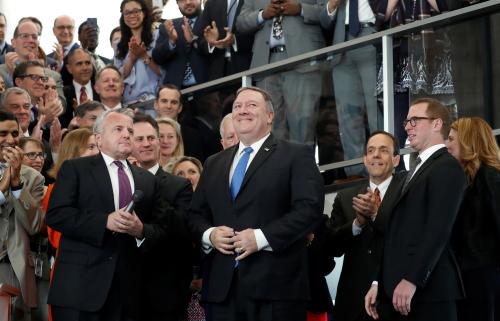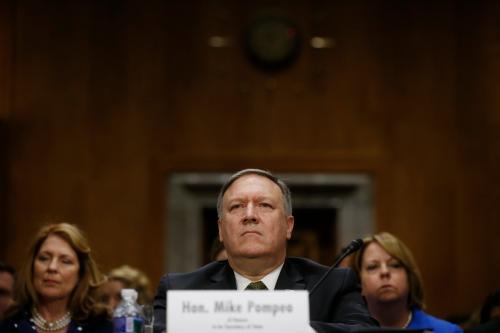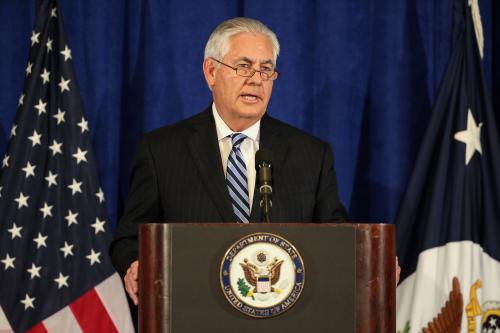The Washington Post and New York Times both ran stories this week which confirm what has been rumored for months: Secretary Tillerson’s tenure at State is nearing its conclusion. As early as February, Trump signaled that the Secretary of State position in his administration would be unlike those in recent memory:
- Tillerson was given little influence over the selection of his own personnel;
- He was excluded from Trump’s inner circle and did not participate in visits from high-ranking foreign dignitaries, like the now-infamous visit of Japanese Prime Minister Abe which was attended by Jared Kushner and Ivanka Trump; and,
- When he did engage in policy matters, the President undermined him as he did last month while on a trip to Asia, publicly Tweeting that Secretary Tillerson’s efforts to negotiate with North Korea were a waste of time.
The one area where Secretary Tillerson was given some leash was on his ambitious “redesign” of the State Department, a laudable objective that has been executed astonishingly poorly. The redesign of State was initiated by the president’s March 13 executive order with draft plans submitted to OMB by September and final plans approved and publicly released by March 2018. But if Tillerson leaves before March 2018, what is to come of the redesign effort?
The redesign effort is likely on life support if not dead already. Maliz Beams, the Department’s Counselor and the lead for the redesign team, quit earlier this week. Perhaps she knows that Secretary Tillerson’s days are numbered and is anticipating the redesign’s death. It is improbable that a new Secretary of State would step into the job and allow a major agency reorganization to take place without having substantive input. If one assumes that a new Secretary of State supports overhaul, the redesign process would probably start afresh with new consultants brought in to scrub what the prior consultants did—all at a cost to the American taxpayers.
A new Secretary of State would more likely decide to shelve the redesign effort and focus his or her time on matters of foreign policy, as most Secretaries have done. In this scenario, the administration would publicly pay lip service to its continued commitment to reform the agency—“draining the swamp” of Foggy Bottom. In practice, the redesign team would finish its work by drafting a document which outlines all the reforms they would’ve done and then placing that document on the shelf to gather dust alongside the 2010 and 2015 Quadrennial Diplomacy and Development Reviews.
If Tillerson is pushed out, it will be a bittersweet ending for the redesign effort. There is little to be excited about from what we know of the proposed redesign plans so far. The only thing that seems clear is that Secretary Tillerson and the White House are committed to shrinking the number of State employees through a slow and painful process of attrition. If Tillerson’s departure ends the ongoing trench warfare with the bureaucrats, then it’s probably a good thing.
However, when Secretary Tillerson took office there was strong bipartisan support for sweeping changes to the State Department. Congressional leaders from both parties, current and former State Department employees, and foreign policy watchers all agree that the Department desperately needs reform similar to what the Goldwater-Nichols Act did for the Department of Defense in the mid-1980’s. Tillerson had the opportunity to advance meaningful and significant reforms but repeatedly squandered his political capital by excluding the three groups he needed most: Congress, department employees, and foreign policy experts. Presumably, the marginalization of these groups was a deliberate attempt to shun “the establishment” but in so doing, Tillerson ensured his redesign would fail.
State refused to engage Congress in the redesign process. It is true that the “listening sessions” included input from some Congressional staff and outsiders but the listening session results appear to have had no influence on the reform proposals under consideration. In addition, feedback from the Congressional committees of jurisdiction was never solicited. During the few meetings between State and Congressional staff, details of the planned reforms were vague and always presented fait accompli. Congressional requests for regular briefings from the redesign team or previews of plan drafts were ignored. Apart from asking Congress to raise the individual buy-out levels from $25,000 to $40,000, State asked for no additional personnel or administrative authorities.
Tillerson alienated Department personnel. Rather than building a consensus within the building, Tillerson and his team isolated themselves on “mahogany row,” the nickname for the row of offices where the Department’s senior officials sit. Again, State did establish “teams” or internal working groups that included approximately 200 people to look at various reform issues but it remains unclear what, if anything, these teams have produced or contributed to the redesign effort. Instead, the redesign has been led by an ever-rotating cast of characters. First, the redesign was led by Tillerson’s Senior Advisor, then leadership was transferred to Deputy Secretary Sullivan’s office for a period before being transferred again to the Director of the Policy Planning Staff and finally to the office of Counselor Beams. Engagement by the people most affected by the redesign—the Foreign and Civil Service officers—has been inconsistent at best.
In September, Tillerson released a preview of his agency redesign plan which was met with a mix of perplexity and frustration. Reading between the garbled consultancy jargon, it appeared that Tillerson was recycling many of the same ideas that had been floated during prior administrations. Tillerson’s redesign slide deck proposed to “ready and empower a 21st century workforce” echoing chapter 5 of Secretary Clinton’s 2010 QDDR. The State redesign team largely ignored the untapped expertise of the numerous think tanks which had excitedly jumped into the State Department reform arena. Groups like Heritage Foundation, Atlantic Council, and the Center for Strategic and International Studies all published reports hoping to have input into the redesign. Instead, State decided to go it alone and when reforms under consideration leaked (e.g. folding USAID into State), it was these same organizations that took the Department to task.
The United States is inextricably integrated into the international system and a functioning, efficient State Department is more critical than ever. However, Tillerson and his team have squandered in spectacular fashion an incredible opportunity to reform the State Department. In so doing, they’ve virtually ensured that successive administrations will avoid the topic which is unfortunate because State is an agency in desperate need of change.










Commentary
What would Tillerson’s departure mean for the “redesign?”
December 1, 2017